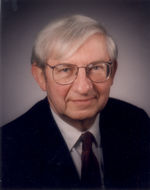
> COCI Visit to China
> News and Notices
> Reports from
Symposia
> New Projects
> Provisional Recommendations
> New Books
> Conference
Announcements
> Conference Calendar
Download the September
issue in pdf format.
(393KB)
Download the September
cover in pdf format.
(71KB)
Chemistry International
Vol. 23, No.5
September 2001Trends in Future IUPAC Activities
Secretary General's report from the IUPAC General Assembly in Brisbane, July 2001
This issue of Chemistry International includes a number of news items from the General Assembly, along with reports on the State of the Union and its financial status. I would like to comment on some aspects of the reports presented to the Council and to look at some trends in our future activities.
"Down Under"Overview President's report Treasurer & Finance report General Assembly Restructuring of the Divisions
This year marks the conclusion of the transition period for converting to a project-driven system. The reports by the Division Presidents and Standing Committee Chairmen indicated that a large number of existing projects are expected to be completed by the end of this year; they were largely optimistic regarding the flexibility of the new system and the opportunities to improve interdisciplinary activities. However, there remain some concerns about the effect of termination of Commissions at the end of the year.
Divisions are handling the new system in quite different ways. For example, the Analytical Chemistry Division will replace its eight Commissions with only one subcommittee (to manage the Solubility Data Series) and will retain its one working party on quality assurance in analytical laboratories. The Physical and Biophysical Chemistry Division will have no subcommittees and will host the reconstituted Commission on Physicochemical Symbols, Terminology, and Units. Both of these Divisions expect to rely on IUPAC Fellows and on contacts with outside groups, including national chemical societies, as sources of ideas for new projects.
On the other hand, the Organic and Biomolecular Chemistry Division and the Chemistry and the Environment Division will retain a much more extensive structure, with a large number of subcommittees in place of their Commissions. In all cases, funds will be available primarily through approved projects. The Macromolecular Division expects to continue about 30 projects as at present, but the Physical and Biophysical Chemistry Division anticipates about 10 projects, with some being supported at much higher levels than was possible in the past.
It will take several years to determine which models will ultimately prove to be most successful.
Some Trends in IUPAC Activities
The final words of the President 's State of the Union message were echoed in several presentations-What does the "customer" need, and why should IUPAC undertake the activity? This emphasis will surely focus our efforts on activities that are widely perceived to be important and that require the unique perspective of IUPAC.
The Union is poised to expand its efforts in chemistry education in ways that clearly complement activities by others, including national chemical societies. The new Vice President, Prof. Leiv Sydnes, has been active in chemistry education in Europe and in helping to develop plans for IUPAC 's work in this area. We should soon see a reconstituted Committee on Chemistry Education, with particular emphases on developing countries and the public appreciation of chemistry.
The new Division of Systematic Nomenclature and Structure Representation will provide the means for IUPAC to maintain leadership in development of chemical nomenclature in the era of computer-based structures and nomenclature. In a broader context, IUPAC will probably take the lead in setting standards for CML (Chemical Markup Language), which seems likely to become the preferred medium for web-based communication in chemistry and for input into printed publications.
IUPAC is increasingly being recognized as an independent international organization that can provide objective scientific advice on global issues. We have begun an effort to advise the Organization for the Prohibition of Chemical Weapons (OPCW) on scientific and technological advances that may have an impact on the enforcement of the Chemical Weapons Convention. More information will be forthcoming in the next two months.
The Union will be making more concerted efforts to expand its membership base of National Adhering Organizations and Associate NAOs, with the lead role being played by the newly established ad hoc Membership Development Committee, chaired by Prof. Hitoshi Ohtaki.
News
and Notices - Organizations and People
- Standing Committees
Divisions
- Projects - Reports
- Publications - Symposia
- AMP - Links
Page last modified 21 August 2001.
Copyright © 1997-2001 International Union of Pure and Applied Chemistry.
Questions or comments about IUPAC, please
contact the Secretariat.
Questions regarding the website, please contact [email protected]

